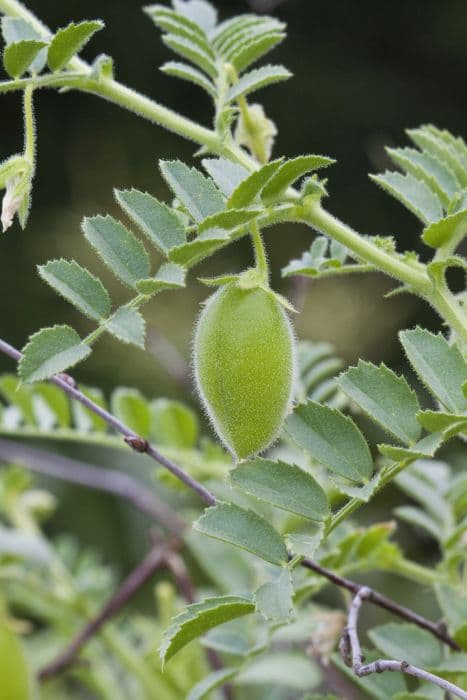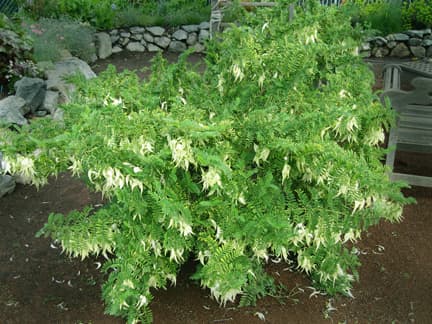Shrubby Scorpion Vetch Coronilla valentina subsp. glauca

ABOUT
The plant commonly known as "shrubby scorpion vetch" is an evergreen perennial with a bushy and rounded appearance. Its leaves are small, delicate, and composed of several pairs of blue-green leaflets that contribute to a fine, feathery texture. Throughout the blooming season, which generally occurs in spring to early summer, it produces charming flowers that are grouped in umbrella-like clusters. These blossoms have a soft yellow hue and are typically small, pea-like, and very attractive to pollinators like bees. The plant is adorned with these cheerful flowers which create a striking contrast against the blue-green foliage. After the flowering period, the plant will produce seed pods that are slender and may add another element of visual interest to its overall presentation. Despite being fairly tolerant to different conditions, this plant does best in well-drained soils and can often be found in coastal or rocky areas, indicating its preference for a sunny spot and its resilience to drought once established. The attractive contrast between its flowers and foliage makes the shrubby scorpion vetch a picturesque addition to gardens or landscapes, where it adds a persistent splash of color across the seasons.
About this plant
 Names
NamesFamily
Fabaceae
Synonyms
Shrubby Scorpion-Vetch, Mediterranean Crown Vetch
Common names
Coronilla glauca, Coronilla valentina var. glauca, Coronilla valentina var. leiocarpa, Coronilla valentina var. phyllacantha, Coronilla valentina var. sierrae, Coronilla valentina var. tenuifolia, Coronilla valentina var. viciosoi.
 Toxicity
ToxicityTo humans
Coronilla valentina, commonly known as shrubby scorpion vetch, is toxic to humans. All parts of the plant contain toxic glycosides, which can cause poisoning if ingested. Symptoms of poisoning may include vomiting, diarrhea, abdominal pain, dizziness, and confusion. In severe cases, cardiac complications such as arrhythmia might occur, potentially leading to serious health consequences or death.
To pets
Coronilla valentina, known as shrubby scorpion vetch, is also toxic to pets. Ingesting any part of the plant can lead to poisoning in animals such as dogs and cats. Symptoms of toxicity may include vomiting, diarrhea, lethargy, drooling, and weakness. More severe reactions could involve changes in heart rate and rhythm, which could be life-threatening if not treated promptly by a veterinarian.
 Characteristics
CharacteristicsLife cycle
Perennials
Foliage type
Evergreen
Color of leaves
Blue-green
Flower color
Yellow
Height
2 feet [0.61 meters]
Spread
3 feet [0.91 meters]
Plant type
Shrub
Hardiness zones
8
Native area
Mediterranean
Benefits
 General Benefits
General Benefits- Ornamental Value: Coronilla valentina subsp. glauca, commonly known as shrubby scorpion vetch, is often used in gardens and landscaping for its attractive yellow flowers and evergreen foliage.
- Drought Tolerance: This plant is well-suited to dry climates, as it is drought-resistant once established, reducing the need for frequent watering.
- Erosion Control: Its root system helps stabilize soil, making it a good choice for slopes or areas prone to erosion.
- Low Maintenance: Shrubbery scorpion vetch typically requires little care, making it ideal for gardeners seeking low-maintenance plants.
- Wildlife Attraction: The flowers can attract pollinators such as bees, contributing to the health of the local ecosystem by facilitating pollination.
- Adaptability: This plant can thrive in a variety of soil types, as long as they are well-drained, making it adaptable to different garden conditions.
- Coastal Planting Suitable: It can tolerate maritime exposure, making it suitable for coastal areas where other plants might not thrive.
- Fast Growth: The shrubby scorpion vetch is relatively fast-growing, which can be advantageous for gardeners looking to establish plants quickly.
 Medical Properties
Medical Properties- There is no reliable scientific evidence to support the use of Coronilla valentina subsp. glauca (commonly known as shrubby scorpion vetch) for medicinal purposes.
- Traditional uses or anecdotal reports of medical benefits are not well-documented or substantiated by modern research.
- Any historical or folk use of this plant should not be considered an endorsement for self-medication or treatment.
 Air-purifying Qualities
Air-purifying QualitiesThis plant is not specifically known for air purifying qualities.
 Other Uses
Other Uses- Coronilla valentina subsp. glauca, commonly known as scorpionsenna, can be used in ornamental hedging due to its dense growth habit and attractive foliage.
- Due to its nitrogen-fixing capability, scorpionsenna can enhance soil fertility when planted in gardens or used in reclamation projects.
- The plant's dense foliage provides shelter and nesting opportunities for small birds and beneficial insects.
- Scorpionsenna, with its bright yellow flowers, can be a source of natural dye, although this is not a widely recognized use.
- It can serve as a companion plant in agriculture, supporting other crops by attracting pollinators with its showy flowers.
- The wood of scorpionsenna can be used for making small crafts or tools, although this is not a primary use given its limited wood volume.
- Dried branches of scorpionsenna can act as a natural fire starter due to their fine, dry twigs that ignite easily.
- The plant's ability to grow in coastal areas makes it useful for dune stabilization and coastal erosion control.
- Scorpionsenna can be included in xeriscaping, designed landscapes that reduce or eliminate the need for irrigation.
- It can also serve as a living mulch, providing ground cover to minimize weed growth and conserve moisture.
Interesting Facts
 Feng Shui
Feng ShuiThe shrubby scorpion vetch is not used in Feng Shui practice.
 Zodiac Sign Compitability
Zodiac Sign CompitabilityThe shrubby scorpion vetch is not used in astrology practice.
 Plant Symbolism
Plant Symbolism- Unity and Togetherness: Coronilla valentina, commonly known as Scorpion Senna, often grows in clusters, symbolizing unity and togetherness.
- Strength in Adversity: As a plant that is able to grow in difficult conditions and poor soils, Scorpion Senna represents resilience and the ability to endure challenging situations.
- Renewal and Hope: With its bright yellow flowers that bloom in spring, Scorpion Senna is often seen as a symbol of new beginnings and hope for the future.
- Protection: Historically, some believed that it could ward off malevolent forces or evil, representing safety and protection.
 Water
WaterThe shrubby scorpion vetch (Coronilla valentina subsp. glauca) should be watered deeply but infrequently, allowing the soil to dry out between waterings. During the growing season, watering once a week with approximately one gallon of water per plant should be sufficient. However, during the winter months or in cooler weather, reduce watering to once every two to three weeks, using the same amount of water. It’s important to ensure good drainage as the plant does not tolerate waterlogged soil. Adjust watering frequency and volume according to your local weather conditions and soil type.
 Light
LightShrubby scorpion vetch thrives in full sun to partial shade. Ideally, the plant should receive at least six hours of direct sunlight each day for optimal growth. A spot that offers morning sunlight with some afternoon shade is also suitable. Avoid deep shade locations, as this can lead to leggy growth and fewer flowers.
 Temperature
TemperatureShrubby scorpion vetch prefers a Mediterranean climate, tolerating a wide range of temperatures. It is hardy in USDA zones 8-10, withstanding minimum temperatures down to about 15 degrees Fahrenheit, but ideally, it should be grown in regions where the temperature does not frequently drop below freezing. The plant performs best in areas where the temperature remains between 50 and 80 degrees Fahrenheit.
 Pruning
PruningShrubby scorpion vetch benefits from occasional pruning to maintain its shape and encourage bushier growth. Pruning should be done in late winter or early spring before new growth begins. Cut back the previous year's growth by about one-third to stimulate fresh growth and flowering. Pruning can be performed annually, but always ensure not to cut into old wood, which may not regenerate.
 Cleaning
CleaningAs needed
 Soil
SoilShrubby Scorpion Vetch (Coronilla valentina) prefers a well-draining soil mix with sandy or gravelly components to mimic its native Mediterranean environment. The ideal soil pH for this plant is slightly acidic to neutral, ranging from 6.0 to 7.5. A mixture of two parts sand or grit to one part compost or loam is recommended to ensure good drainage and provide sufficient nutrients.
 Repotting
RepottingShrubby Scorpion Vetch does not require frequent repotting; it is typically done every two to three years or when the plant has outgrown its container. Ensuring the new pot is only slightly larger than the previous one helps prevent overwatering issues due to excess soil.
 Humidity & Misting
Humidity & MistingShrubby Scorpion Vetch thrives in typical indoor humidity levels and does not require any special humidity conditions. Being native to coastal and dry inland regions, it can tolerate a wide range of humidity levels without issue.
 Suitable locations
Suitable locationsIndoor
Place in bright light, limit water, avoid high humidity.
Outdoor
Full sun, well-draining soil, protect from extreme cold.
Hardiness zone
8-11 USDA
 Life cycle
Life cycleCoronilla valentina subsp. glauca, commonly known as Shrubby Scorpion-vetch, starts its life as a seed that germinates in favorable conditions usually during spring or autumn. Following germination, it develops into a seedling with characteristic trifoliate leaflets. As it grows, the plant forms a woody base with numerous herbaceous shoots, entering its vegetative stage, and demonstrates its drought-resistant nature by establishing a deep root system. During its reproductive stage, which typically occurs in the spring, it produces clusters of bright yellow, butterfly-attracting flowers. After pollination, flowers develop into seed pods that mature by late summer or early autumn, eventually releasing seeds that contribute to the spread of the plant. The plant is perennial, and after flowering, it goes dormant over the winter only to regrow from the woody base the following season.
 Propogation
PropogationPropogation time
Spring to early summer
Propogation: Coronilla valentina subsp. glauca, commonly known as Shrubby Scorpion-vetch, is primarily propagated through seed sowing. The best time for sowing seeds of this Mediterranean perennial is in late winter or early spring, after the risk of frost has passed. To propagate by seed, one should first scarify the seeds by gently rubbing them with sandpaper or nicking the seed coat with a knife to break their dormancy. After scarification, the seeds are soaked in warm water for 24 hours (about 77 degrees Fahrenheit or 25 degrees Celsius) to further enhance germination. Sow the seeds in well-draining soil at a depth of about 1/4 inch (6 millimeters). The soil should be kept moist, but not waterlogged, until germination occurs, which typically takes place in two to four weeks. Once seedlings have developed a few true leaves, they can be transplanted to their final growing location, ensuring they receive full sun to part shade and well-drained soil to thrive.




![Kowhai [Sun King]](/_next/image?url=https%3A%2F%2Fplants-admin.emdemapps.com%2Fimages%2Fplants%2F%2Fimages%2F604b57cb7f598.png&w=640&q=75)




